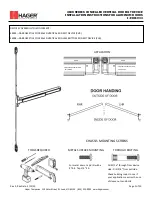
44
Description
Possible Cause
Remedy
8 Electrode melts or
oxidizes when an arc
is struck.
A No gas flowing to
welding region.
A Check the gas lines for kinks
or breaks and gas cylinder
contents.
B Torch is clogged with dust.
B Clean torch.
C Gas hose is cut.
C Replace gas hose.
D Gas passage contains
impurities.
D Disconnect gas hose from
torch then raise gas pressure
and blow out impurities.
E Gas regulator turned OFF.
E Turn ON.
F Torch valve is turned OFF.
F Turn ON.
G The electrode is too small for
the welding current.
G Increase electrode diameter or
reduce the welding current.
H
WAVE BALANCE
is set above
50%.
H Reduced
WAVE BALANCE
to
below 50% or increase the
electrode size.
9 Poor weld finish.
Inadequate shielding gas.
Increase gas flow or check
gas line for gas flow
problems.
10 Arc flutters during
TIG welding.
A Tungsten electrode is too
large for the welding current.
A Select the right size electrode.
Refer to Basic TIG Welding
guide.
B Absence of oxides in the
weld pool.
B Refer Basic TIG Welding
Guide for ways to reduce arc
flutter.
11 Welding arc cannot
be established.
A Work clamp is not connected
to the work piece or the
work/torch leads are not
connected to the right welding
terminals.
A Connect the work clamp to the
work piece or connect the
work/torch leads to the right
welding terminals.
B Torch lead is disconnected.
B Connect it to the ‘
−
‘ terminal.
C Gas flow incorrectly set,
cylinder empty or the torch
valve is OFF.
C Select the right flow rate,
change cylinders or turn torch
valve ON.















































